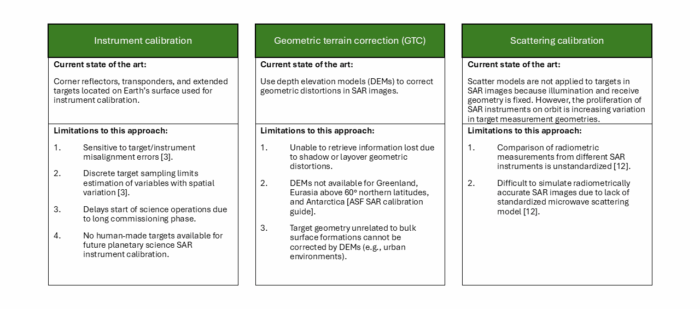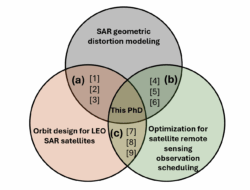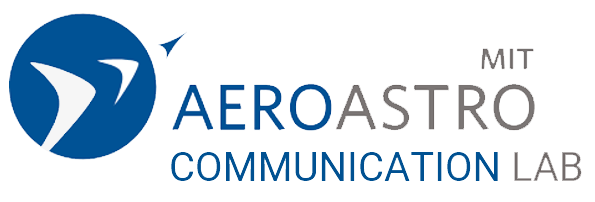1. Introduction
Congratulations! You’re responsible, in some shape or form, for defining a research effort. You might be a PhD student working towards your PhD proposal defense, a master’s student drafting a fellowship proposal, or an undergraduate student crafting a project for a course. Whatever stage you are in and whatever your research effort is, congratulations. This is one of the most exciting times in the process of a research project because it is when you are free to explore and strategically craft your vision for how the outcomes of your efforts fit into the context of a bigger picture. The formalization phase of your research is one of the most essential on the technical communication front. Effective communication of knowledge gaps, research questions, objective statements, and contribution statements will set yourself up for success in the proceeding phases. Thorough definition of these facets of a research formalization using a systematic approach will ensure you have complete and concise answers to questions like:
What is your research on?
How does your research fit into the context of the current state of the art?
Who will benefit from the outcomes of your research?
2. Criteria for Success
- Your focused questions bound the scope of your research and identify gaps in knowledge that are important and addressable.
- Your objective statements clearly articulate what you will do, how you will do it, and within what constraints.
- Your contribution statements describe the novel insights, advancements, and solutions of your research within the broader context of the field.
3. Purpose
The purpose of this CommKit is to provide a framework for formally communicating the establishment of your research topic. In this context, formal communication of a research topic is accomplished through presentation of:
- A rigorous gap analysis and research focus areas
- A set of research questions and objective statements
- A set of contribution statements
4. Intended Audience and Context
Formal communication of a research topic occurs in several contexts. The most obvious context is one in which a review of proposed research takes place. Most institutions require such reviews for early-stage graduate students in master’s or PhD programs in the format of a proposal defense to a committee of experts in the field. Formal research topic communication can also benefit graduate students writing their first conference and journal research articles or research funding proposals by elucidating the scope of their work in the context of the current state of the art. Formal research topic communication is also beneficial in non-review based settings, such as in communication of research ideas to a public audience with varying levels of expertise and to potential collaborators at other institutions.
Regardless of the specific setting, the framework presented in this CommKit assumes initial brainstorming and project formulation has been carried out as described in the formulating a research topic blog post. Specifically, this CommKit assumes that a draft research statement has been created along with a Venn Diagram of literature organized according to draft focus areas. While different research advisors have different expectations, carrying out the framework described in this CommKit should satisfy a significant set of requirements in the phase leading up to an in-depth review of your research topic, such as during a PhD proposal defense.
While the content provided in Section 5 references highly-specific materials used in the author’s own research formalization process, the presented communication framework was developed to be generally applicable. The example materials are the final versions of topic formalization work derived after several iterations with feedback from thesis advisors. These materials should not be considered as the “correct” way to communicate a formalized research topic. Rather, they serve as one realization of the central technical communication-related thought processes at play.
5. Formalizing a research topic
5.1. Gap analysis and focus areas
To formalize a research topic, one must first identify gaps in current knowledge. Several types of research gaps exist ranging from an unknown physical principle to a computational resource limitation to a lack of a systematic analysis of a data set. Effective communication of these gaps benefits from a systematic approach that is taken to identify gaps within the context of current practices. If we imagine your research in the context of inputs and outputs, we can start to string together a set of concepts that lead from what you currently have to what you are trying to develop. For example, if your primary interests involve improving synthetic aperture radar (SAR) technologies to enable science discoveries through Earth and planetary remote sensing, your input could be raw SAR data collected by a satellite and your output could be a processed SAR image that is maximally useful for a given application area. Communication of the steps that take place to evolve the input into the output can be accomplished as shown in Figure 1:

Figure 1. Diagram showing steps involved in translating raw SAR data into a processed SAR image.
Various calibration and data processing steps occur before a SAR image output can be useful to an end-user. If your interest is in improving the utility of the output data, we can assume that your research would involve one or multiple of these steps. We henceforth refer to these steps as “topic areas.” To identify gaps in topic areas that need improvements, you must first survey the relevant literature. Example Google Scholar or Elicit searches could be:
- “SAR calibration overview”
- “SAR geometric terrain correction overview”
- “Radar scattering properties overview”
Scanning through the results for each of these searches, you would find articles and textbooks such as the following:
- “SAR calibration: an overview” A Freeman
- “Flattening gamma: Radiometric terrain correction for SAR imagery” D Small
- “Handbook of radar scattering statistics for terrain” by F Ulaby, MC Dobson, JL Álvarez-Pérez
Within each of these references, an overview of the current state of the art is provided. Make note of the current accepted practices and standards for each topic area by carefully reading introduction and background sections. Typically, overviews or seminal works in the literature will also include a future works section that identifies challenges and limitations to current approaches. Note these challenges and limitations since they typically guide future works that build on current approaches and can be what motivates the research you pursue in your work. To organize your understanding of current approaches and their associated limitations, construct a table for each topic area as shown in Figure 2.

Figure 2. Table visualization of processing SAR data step current practices and limitations. Limitations should be tied to specific references to provide traceability.
In Figure 2, each topic area has a brief description of the current approach and several associated limitations listed with relevant citations. These limitations are the gaps we sought to isolate at the beginning of this analysis. A research topic can be built around one or a combination of multiple gaps identified in this analysis. However, our gap analysis work is not finished. Simply identifying gaps in current approaches is not enough. Just because a gap exists does not mean it is worth spending years filling. Furthermore, some gaps exist for good reasons – they may not be solvable due to other external factors. It is essential that a PhD topic centers on a gap(s) that is both important to fill and feasible to address. The overarching research statements you developed during the initial topic formulation process can be posed as overarching topic questions. Generally, this can be accomplished by inserting the word “Can” followed by what you are proposing to do. Using these overarching questions, you can narrow down the gaps identified in the above analysis to a smaller subset that are important and achievable as shown in Figure 3. Note that the “by” portion of your initial overarching research statement describing how you will accomplish what you are proposing flows down from the overarching question as an intermediate step in the diagram.

Figure 3. Research focus area flow-down diagram. Starting from an overarching question, focused research areas are derived.
We call this set of filtered down gaps “focus areas” since they are not only gaps in knowledge, but they are important to solve and have feasible solution paths. Starting from an overarching question that is derived from your high-level research statements, flow down into the gaps. You may find that some gaps are related to one another and may therefore be considered as a single encompassing gap. Further literature review can reveal how many scholars have identified each gap as a challenge halting progress to inform your understanding of their importance. Further literature refinement should be reflected in the Venn Diagram organizational structure you created during the topic formulation phase. An example of a refined literature Venn Diagram for the 2a focus area in Figure 3 is shown in Figure 4 below.

Figure 4. Literature Venn Diagram. Focus area(s) is(are) located in the middle and surrounded by closely related and interconnected fields of literature.
Formal communication of your gap analysis and focus area(s) can benefit from assessing project practicality. Discussions with researchers and practitioners in the field can inform you of the accessibility of resources that could help address each gap. In particular, finding open-source software repositories is an excellent way to determine whether the solution to a gap is feasible in the context of your project. Adding information on the practicality of your proposed research via a note in the footer of a document or another form of annotation demonstrates the effort you put into vetting the feasibility of your project. Generally speaking, the more existing resources you can find that work towards a solution to a given gap, the more feasible the gap’s solution becomes.
5.2. Focused questions and objective statements
The next step in topic formalization is the derivation of focused questions and objective statements. Focused questions serve as a stepwise set of milestones, posed as questions, that must be affirmatively answered to fully address a focus area. For example, if we select focus area 2a from the subset shown in Figure 3, several steps must be taken before geometric distortions can be systematically minimized in SAR images, naturally prompting the question of whether these preceding steps can be accomplished. An example set of focused questions, along with an overarching question, for this focus area is shown in Table 1 below.
Table 1: Overarching research question with an accompanying set of focused questions.
| Overarching Question: | Can knowledge of a target scene’s topography be incorporated into the SAR satellite observation planning process to improve the reliability and accuracy of collected imagery? |
| Q1 | Can digital elevation models (DEMs) and simulated satellite overpass trajectories be used to generate geometric distortion masks of ROIs at any location on the Earth’s surface from all possible observation geometries? |
| Q2 | Can a metric that quantifies the expected visibility of a pre-defined ROI from a given observation geometry be created while accounting for topographic uncertainty? |
| Q3 | What changes in overall system performance occur if ROI visibility is explicitly integrated into the observation scheduling process for a constellation of SAR satellites? |
Note that the overarching question was rephrased to align with the selected focus area. The focused questions bound the scope of your PhD research topic since specific gaps in knowledge are being referenced based on your gap analysis. With an overarching question and a set of focused questions posed, objective statements naturally flow. While there are different ways to structure an objective statement, generally, they describe a goal and an approach for accomplishing it. A well thought-out overarching objective statement and set of focused objective statements communicate the main ideas of your PhD research and can offer a thorough answer to the question: “What is your PhD on?” Table 2 below shows an overarching objective statement along with a set of focused objective statements for focused questions 1-3 in Table 2.
Table 2. Overarching research objective with an accompanying set of focused objective statements.
| Overarching Objective: | Demonstrate improvement in SAR data product utility by planning observations using a-priori knowledge of local topography while accounting for uncertainty in overpass geometry and topography model. |
| O1 | Create simulation package that produces geometric distortion maps by interfacing orbit propagator and ISCE3 while maximizing computational efficiency. |
| O2 | Create a metric that quantifies visibility of different observation geometries by analyzing geometric distortions within predefined ROI while accounting for topography model uncertainties. |
| O3 | Determine the effects of incorporating ROI visibility into the observation scheduling process on traditional system performance measures for constellations of SAR satellites. |
Note that the objective statements use the “to…by…while…” sentence structure described in the formulating a research topic blog post. Using this structure is effective in communicating what you will accomplish, how you will accomplish it, and which constraints you will account for. In some cases, focused objectives will need to be accomplished in chronological order. Identifying such critical path objectives with an asterisk or other symbol can be useful for yourself and others to demonstrate your awareness of overall project timeline constraints.
5.3. Contributions
With focused research questions and objectives defined, you are ready to enumerate your contributions. Contribution statements clearly define the novel insights, advancements, and solutions your research offers to the field. An additional option would be to identify the contribution type, such as new theory, method refinement, and new application, for each statement via a color scheme. Example contribution statements for the focused objectives enumerated in Table 2 are shown in Table 3 below.
Table 3. Contribution statements associated with each focused objective statement.
| C1 | Extension of open source radar processing packages to efficiently generate distortion masks over the complete observation geometry sample space. |
| C2 | Definition of a metric that quantifies the visibility of a ROI from a given observation geometry that accounts for uncertainty in the underlying topographic model. |
| C3 | Quantification and analysis of observation scheduling performance with and without visibility information for a variety of task lists and satellite constellations. |
Note that each contribution statement begins with a verb and provides a detailed description of the context related to the contribution. Depending on your number of contributions and their relative interdependency, they can serve as an outline for your PhD dissertation content chapters.
6. Additional Resources
- Formulating a research topic blog post
- First PhD committee meeting Comm Kit
- Scribbr – Research Objectives | Definition & Examples
- Thesis proposal Comm Kit
7. Acknowledgements
Thank you to Harsh Bhundiya, for feedback and guidance through the editing process of this CommKit.
